Optimization for Marketing Mix Modeling
What You Need to Know
Optimization for Marketing Mix Modeling
What You Need to Know

After creating your Marketing Mix Model, you need to provide the business with actionable insights they can use to optimize the performance of their brands. This is where Optimization comes in, as part of the deployment phase of the MMM workflow.
If you’re not confident yet with your model performance, check the previous article, from this series, on the modeling phase. Optimization can only give meaningful results if the previous steps were properly done.


Figure 1
Optimization, alongside prediction, represents the insights you are meant to provide your client, based on the measurement that you did in the first part of the MMM pyramid.
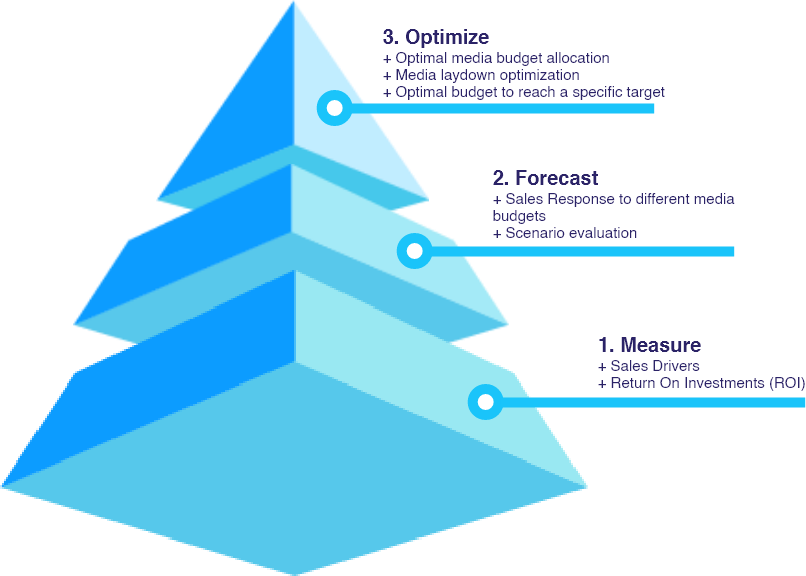
Figure 2
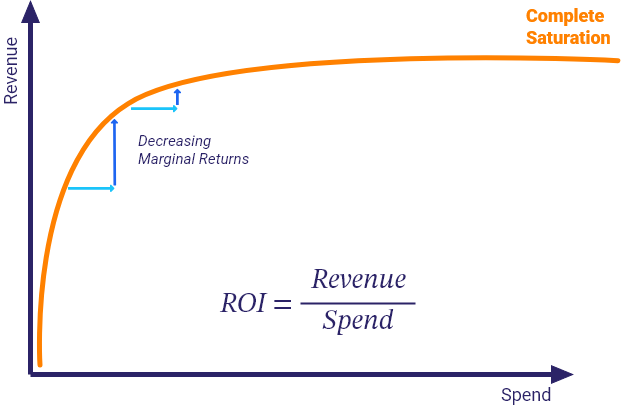
Figure 3
How Optimization Works

Figure 3
Optimization is based on the outputs we get from the diminishing returns curve.
Basically, the more a business spends on a specific channel, the more revenue they generally make. However, their marginal returns will keep decreasing.
In other words, as their spend increases, the return that they would get from each additional dollar will decrease. This is generally represented by either a concave or an S-shaped curve. The graph on the left is an example of a concave one.
As shown in figure 3, complete saturation is when the slope becomes gradually flatter approaching the upper limit of the curve. This means that if the business spends an additional dollar on that channel, it will hardly get any revenue. Thus, it is useless for them to spend more money on that channel. That is when they need to move money from that saturated channel to a less saturated one.
However, to optimize between the channels, ROI alone is not enough. It is important to look at the level of saturation in each curve to decide where to spend the next dollar.

ROI being high does NOT mean that the business should invest more in that channel!
In the chart on the right, there are two channels: TV and Search.
The TV ROI is higher than Search. By decreasing the budget of television and placing the same amount on the Search activity, the results will be:
- A decrease in the contribution (the incremental revenue) from television.
- An increase in the contribution from search because search is not as saturated as television.
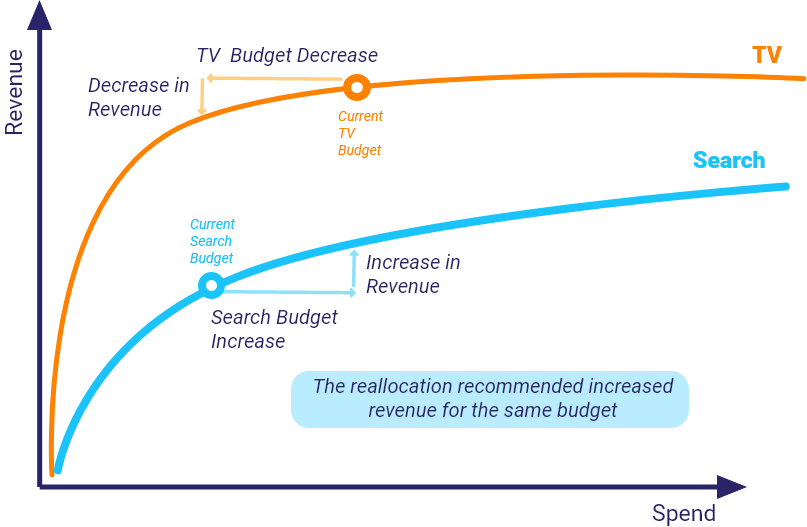
Figure 4
The gain from search is more significant than the loss caused by TV. By keeping the same budget and switching a part of it from television to search, the total net revenue was improved. And that is exactly how optimization works!
Optimization Walkthrough
We have $50k to be invested in 3 channels: TV, Radio, and Display.
The first step is to derive the diminishing returns curves for the 3 channels. Then split the budget into increments, in this example we have chosen the following increments: $10K, $20K and $30K
Iteration 1
Use the slope of the three diminishing returns curves to decide where to place the budget we have for the first increment of $10k Project the first $10k on the Display/TV/Radio curves and compare the resulting revenue:
Based on the curve on the right, the highest slope is for television. This means that the first $10k should be allocated to television. At the end of this iteration, we obtained:
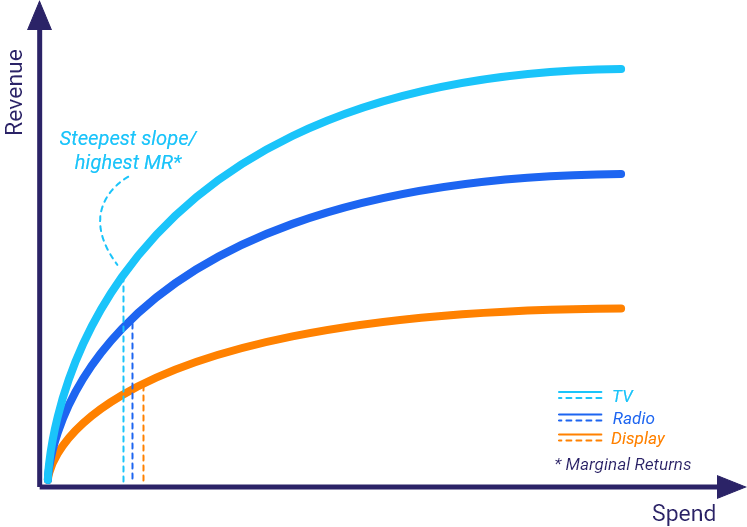
Figure 5
0 investment in display.
0 investment in radio.
$10k investment in TV.
⇒ We still have $40k to allocate.

Figure 5
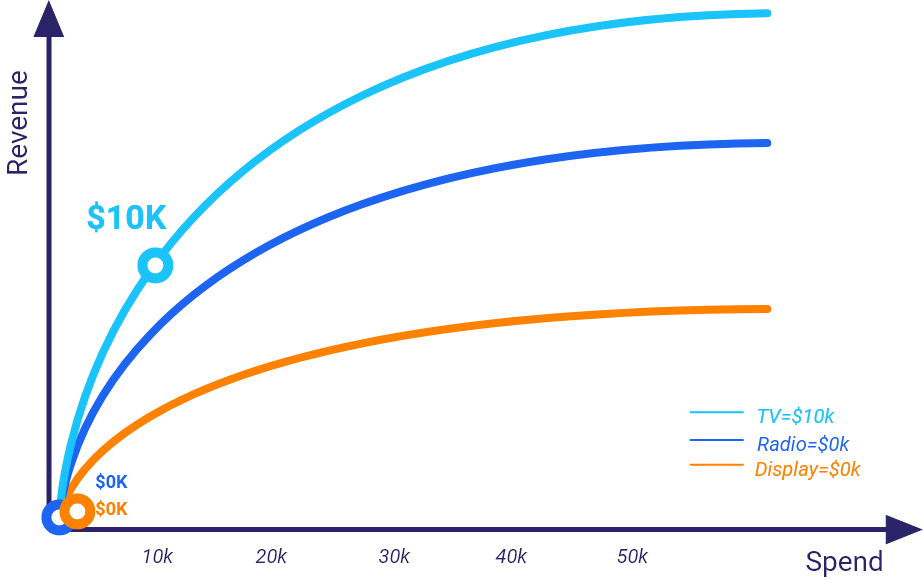
Figure 6
Iteration 2
Project the second increment, $20k, on the Display/TV/Radio curves and compare the obtained returns (Y-axis).
Note that for TV we are not starting from 0 but from $10k as we have already allocated this amount to TV in the first iteration: what we obtain from the TV curve is the marginal returns of placing an additional $20k on TV knowing that we have already invested $10K in this channel.
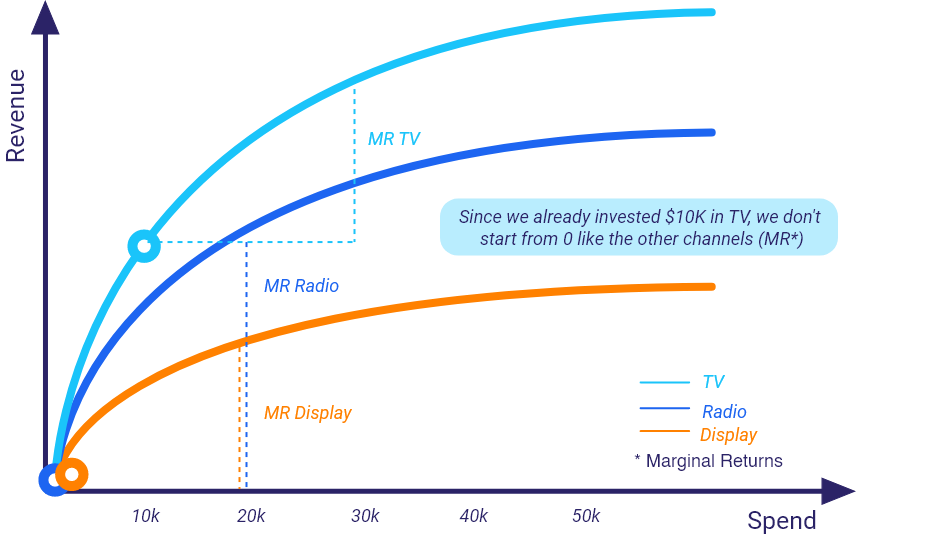
Figure 7
Comparing the 3 marginal returns, the blue line (radio) is the highest. This means that the next $20k will be placed on Radio.
Iteration 3
To decide where to place the last $20k, the same procedure is followed as before.
The highest slope is again for television. So, the decision is to place the last $20k on television.
The final optimal allocation is:
TV gets $30k ($10k from iteration 1 and $20k from iteration 3).
Radio gets $20k from iteration 2.
Display does not get any money.

Figure 8
Recommended Optimization Process
Based on our experience, we recommend to follow these steps for seamless optimization:
Step 1: Apply Variable Transformations (AdStock, Carryover…)
When consumers are exposed to media, they do not necessarily go immediately to the stores/online to buy the product. There is a carryover effect that needs to be accounted for. To do so, transformations like AdStock are used. Some algorithms give the possibility of creating an AdStock that models the short-term and the long-term effect of advertising.
Step 2: Add Diminishing Returns Functions
AdStock is a linear function. It does not produce the concavity that allows for optimization. That’s why It is essential to apply a functional form that will produce a concave shape, for example, the exponential function. Some analysis prefer to apply S shaped curve at this stage.
Step 3: Create multiple curves
For example, vary the parameter in the exponential function to create multiple curves; that parameter controls saturation. Hence, each curve represents different level of saturation to be tested at a later stage.
Step 4: Apply a model selection algorithm
This is the process through which we choose the right curve that should go into optimization while considering all the other factors in the model. The curves must make sense to you when you visualize them. They should not be highly saturated, or not at all saturated. Highly saturated curves mean that one could not invest money in that channel. Whereas a linear curve indicates a constant increase in revenue. This will lead the algorithm to invest all the money in that channel, which is not realistic.
Step 5: Optimize budget
Once you have found the curves that best fit your data, they can be fed into the optimization to allocate the budget optimally.
Common Mistakes When Optimizing MMMs
Forgetting The Business Perspective
Optimization is an exercise that should not be done in a closed room. It is important to get input from the business and the media planners. So that you deliver to the business actionable and implementable insights.
Sometimes there are constraints that are related to reality that should be taken into consideration. For example, there is a limit of inventory in a specific media channel, which requires setting up a maximum limit on the amount of money to invest in that channel.

Asking the opinion of the manager, or subject-matter experts , is advisable as they might have valuable insight and experience to share about this part of the process.

Not Iterating Enough
Perform your optimization and modeling iteratively. They are not sequential steps and treating them as such might lead to bad surprises.
For example, you have created your model, computed your ROI and contribution, and reported your results to the business. Then the business asks you to do an optimization based on that model.
When you run the optimization, you discover that some of your channels are highly saturated, and the other ones are not at all saturated. This would push any optimization algorithm, to not put any money on the saturated channel, and invest all of it in the non-saturated channels. This is not something that your client would accept.
When you are running your models. You need to make sure that you are keeping an eye on the results of the optimization. You can only say that you have finalized your project when both modeling, optimization, contribution, and ROI make sense to you.
Conclusion
The backbone of any optimization exercise is the definition of diminishing returns curves. To define a successful diminishing returns curve, make sure you transform the variables, apply decay, diminishing returns, create different sensible curves then use some kind of model selection to find the right curve.






